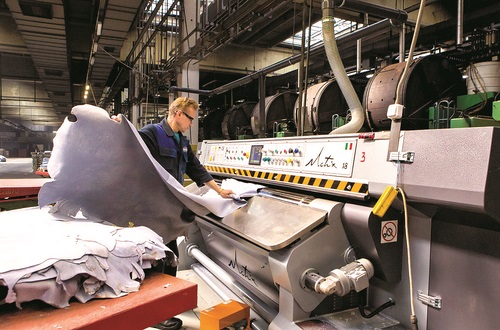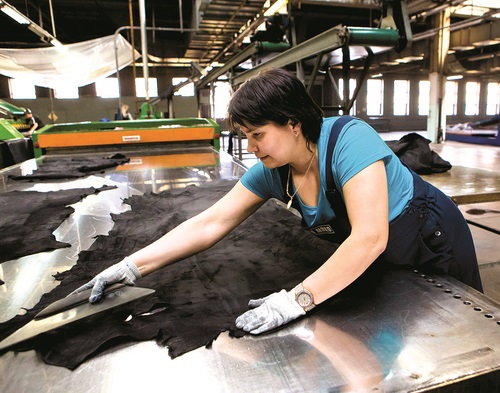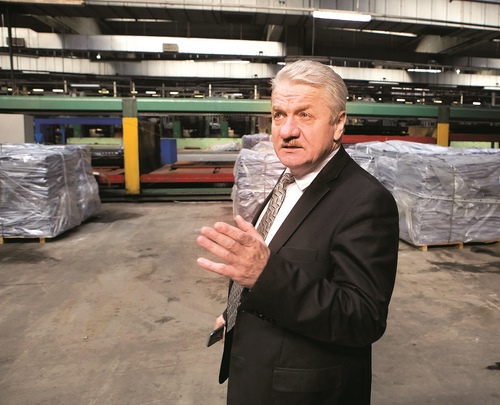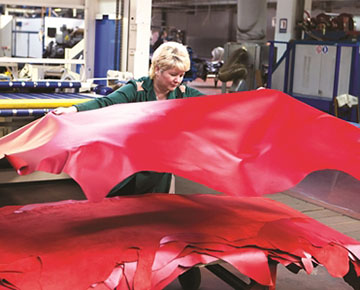The old Soviet leather-dressing enterprise in Gatovo was once among the most contemporary, but was in vital need of modernisation a few years ago. In fact, 90 percent of machinery was out of date and in need of replacement. In 2010, Minsk Leather Production Association manufactured just 68m square decimetres of ready-made leather goods. It was no longer profitable, with losses of almost Br3bn. Now modernised, its production volumes have increased 2.5-fold (compared to 2010), and net profits are almost Br14bn. Is it a miracle? Hardly! The results are due to the President’s decision to technically re-equip the enterprise, and to appoint a new director (to act as an anti-crisis manager) alongside painstaking hard work. Gatovo now boasts a modern company.

Several years ago, the company primarily manufactured and exported ‘wet-blue’ semi-finished products with low added value, for cheap sale abroad. These then returned to the country as expensive imported leather footwear and bags. In 2013, the company gained a loan worth 20m Euros (plus Br40bn) to conduct modernisation.
The Director General of Minsk Leather Production Association and Chairman of the board of directors for leather and footwear enterprises, Nikolay Yermakov, tells us, “The crisis of 2014 made us to tackle our business plan thoroughly. We understood that major modernisation required not only the throwing away of old equipment and the installing of new but a different way of thinking, and the necessity for a team of like-minded persons. As far as technical re-equipment was concerned, we aimed at expanding workspace, replacing tanking tanks, automating our liming drums, and installing a modern finishing line and a reverse dyeing line, as well as cloth mellowing machines and a mirror vacuum-drying machine…”

In all, 10m Euros (instead of 20m) was spent on modernisation, enabling the company to replace equipment and ensure necessary volumes of processing and production of ready-made leather goods. Meanwhile, Br40bn was spent on the purchase of raw materials. All factors have enabled the company to gain momentum, significantly increasing volumes of ready-made goods. Moreover, despite economic difficulties, two vital tasks have been solved: providing furniture and footwear industries with raw materials and creating good working conditions for employees. The average monthly salary has risen almost 7-fold since 2010.
Mr. Yermakov expects that, by November, modernisation will be complete and capacity will have risen to 1,500-1,700 tonnes of raw leather processed annually. The task is theoretically feasible, although there is currently a deficit of raw material. The Director remembers Mr. Lukashenko’s visit, in September 2014, when he announced his goal for the whole leather industry, stating that Belarus should process raw materials, to enable them to supply manufacturers of footwear, furniture and haberdashery.

At the Leather Production Association
Unfortunately, not all plans announced at that time have been realised. In the first six months, only 52 percent of modernisation had been carried out across the industry. According to Mr. Yermakov, there is some way to go in co-ordinating supply of raw leather directly from meat processing factories. He comments, “Managers at meat-packing plants don’t yet fully understand the needs of the state in meeting its goal. Experiencing export problems, they’re ready to export skins or ‘wet blue’ semi-finished products, although these bring little profit. What do we have as a result? We could turn these skins into a high quality product domestically, exporting 50 percent, to earn foreign currency for our country, while selling the rest half to our furniture and footwear factories (which currently import 50-70 percent of their leather). The country’s livestock industry rivals that of Europe, so it’s a sinful waste to sell our leather abroad so cheaply, without engaging in full processing.”
With its new equipment, the factory in Gatovo can process up to 1,200 tonnes of raw material daily. However, at present, its capacity is running at no more than 850-900 tonnes, with half of its processed volume returned from the factory in Gatovo to meat-processing factories. Meanwhile, modern equipment is not working at full capacity, which considerably raises cost per unit. The Director hopes that raw material difficulties will soon be solved.

Nikolay Yermakov
At present, Minsk Leather Production Association is successfully exporting its goods, with most going to the Baltic States, Poland, Spain and Portugal. Recently, the enterprise mastered sales to India, China and Vietnam. Last year, export revenues exceeded $15.5m. However, while physical volumes of exports grow, their value is falling. Gatovo workers remain optimistic though, knowing that modernisation has opened up major opportunities for the company and that the future is bright.
By Polina Kononova











